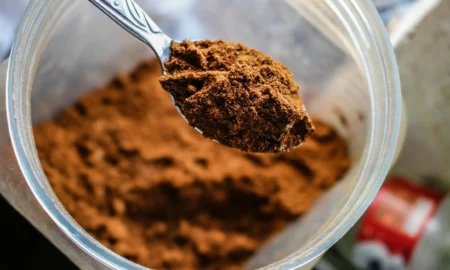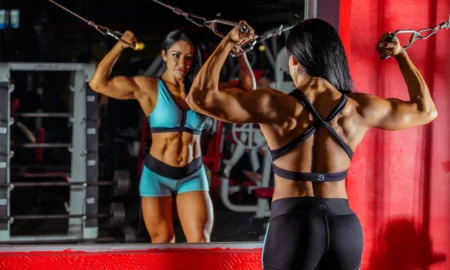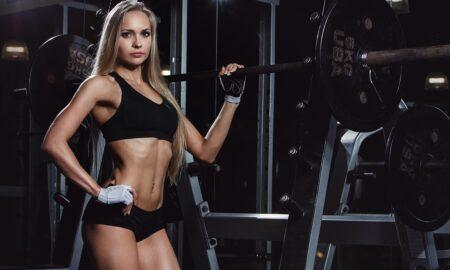Q: You look fantastic for a a natural bodybuilder. I’m 17 years old, 5’6” and a measly 123 pounds. I’ve been lifting weights and eating a good diet for about six months now and have made great changes in shape but not so much in size. I’d like to ask about rep ranges for hypertrophy and strength. The higher reps seem to work best for most—even Ronnie Coleman, who is massive, advocates 10 to 12 reps for legs and shoulders. Then I saw in your March ’10 column, “New Size for Skinny Guys,” that you think six to eight is best. Do steroids affect the rep range for growth? It seems to me that using low reps on moves like the bench and row will always make the smaller muscles—triceps and biceps—give out before the target muscles in the chest and back.
A: The question of how many repetitions to perform is confusing for many bodybuilders. Some like to do low reps with heavy weights, while others do higher repetitions with less resistance.
I’ve always believed that the best repetition range for building muscle mass is six to eight. When you’re using resistance that’s heavy enough to limit you to only six to eight repetitions, you’re making the muscle fibers thicker. You’re also primarily affecting the type 2 muscle fibers, the fast-twitch fibers that are most responsible for the size of a muscle.
In addition to thickening the muscle fibers, the six-to-eight-rep range enables blood and other nutrients to be pumped into the sarcoplasm—the area around the muscle cells—which accounts for more muscle size. That number of reps puts the muscle fibers under tension long enough to let more growth take place.
So the key to getting bigger muscles is to use increasing resistance in the six-to-eight-rep range. For example, if you can currently squat 225 pounds for six to eight reps in perfect form, by the time you work up to squatting 275 pounds for six to eight reps using the same form, your legs will be bigger.
When you train very heavy and can do only three to five reps per set, you’re developing more strength than size. You’ll also be affecting the fast-twitch muscle fibers with that rep range, but you won’t get the same pump, pushing blood into the muscles, because of the limited reps. So you’ll develop more strength by making the tendons and ligaments stronger.
When you use higher reps, you affect different fiber types. The 2A muscle fibers have characteristics that are like both the slow-twitch fibers and the fast-twitch fibers, which are the type 2Bs. Type 2A fibers are moderately resistant to fatigue and are relatively dense in mitochondria and capillaries. That makes them well suited to aerobic activities, which also require a great deal of power.
Doing a greater number of repetitions—10 to 15—will also pump more blood into the muscles, creating full engorgement. The blood brings nutrients into the muscle cells and, as mentioned above, increases the size of the sarcoplasm. You can definitely increase the size of the muscles by using higher reps.
Upping your reps, however, will limit the amount of weight you can use. If you don’t get stronger, you won’t get significantly bigger because you won’t be increasing the size of the muscle fibers.
Some bodybuilders mistake getting a pump for increasing muscle size. Although pumping lots of blood into the muscle will make it bigger, the real growth comes from training heavier and increasing the thickness of the muscle fibers. When someone told four-time Mr. Universe Bill Pearl that he got a great burn and pump in his calves by doing calf raises with only his bodyweight for resistance, Bill replied, “I can get a burn in my calves if I put a match to them, but it sure as hell won’t make them bigger.”
It’s very possible that the steroids and other performance-enhancing drugs bodybuilders use will enable them to grow or maintain mass while using higher reps or even pumping workouts done with light weights. I’ve seen many examples of incredibly massive bodybuilders using very light weights and pumping their muscles to gigantic proportions. The combination of anabolic steroids, growth hormone and insulin permits that to happen. If a natural bodybuilder tried that, he would not get the same results, trust me.
If your smaller muscle groups, like arms and shoulders, are giving out when you use heavy weights on the basic exercises for bigger muscle groups like chest and back, that may be because you’re still new to training. People who haven’t lifted weights before often feel the movements in their smaller muscle groups when training the bigger groups.
I believe you have to develop a certain amount of strength throughout your whole body before you’ll be able to connect with the bigger muscle groups. After you’ve been training for a while, you’ll be able to feel the mind/muscle connection and focus on the muscles you’re trying to develop with each basic exercise that you perform.
Q: I’ve been bodybuilding for a couple of years and have some questions. I go to the gym five times a week. I do chest on Monday, back on Tuesday, shoulders on Wednesday, arms on Thursday and legs on Friday, taking Saturday and Sunday off. My workouts are very intense, and I’ve been following a good program: about one hour and sometimes with 15 minutes of cardio. I’m sure I have problems with my nutrition. I’m 5’10” at 160 pounds. I’ve lost eight pounds during the past two months, on a diet containing about 2,200 calories. I eat carbohydrates—especially oats, rice and pasta—in the morning and afternoon—and work out in the evening. Surfing on the Internet, I saw that I needed more calories, so I increased carbohydrates. I’m completely natural and have never used integrators—and don’t want to. My big problem is fat on my abdominals. I like my body and don’t want to get too big, but I do want to gain some pounds. What kind of diet can I follow to get more muscles while keeping fat off of my abs? How many calories should I get? How many carbohydrates, and which kind?
A: Yours is a common problem among bodybuilders today. They want to get bigger and increase the size of their muscles, but they don’t want to add any fat while they’re doing it.
Well, that’s very difficult to do. In order to get bigger, you need to eat a certain number of calories along with the right combination of the three basic macronutrients: protein, carbohydrate and fat. To get or stay lean, you need to decrease the number of calories you take in while also reducing your carbohydrate and/or fat.
Can you see the problem? Getting bigger requires more calories, and getting lean requires fewer calories. They are two opposing strategies. You can’t do both at the same time.
Unless you’ve never weight-trained before or are coming back to training after a layoff, it’s almost impossible to gain muscle while losing fat. You seem to have a pretty fast metabolism, and you need to gain more size. That won’t happen unless you eat more.
How many calories you need depends on how fast your metabolism is. That depends a lot on your age, your activity level and your body type—endomorph, ectomorph or mesomorph. To add size, you need to match your calorie intake with your metabolism.
Begin by figuring out how much protein you need. Protein is the building block of muscle tissue, and you need it to rebuild the muscle tissue you tear down in the gym. I suggest eating approximately 1.25 to 1.5 grams of protein for each pound of bodyweight. At 160 pounds you’d need 200 to 240 grams of protein a day.
The next macronutrient to focus on is complex carbohydrate. You’re eating complex carbs daily, but you may not be eating enough. You’ll probably need at least two to three grams of complex carbs for each pound of bodyweight. That would come out to 320 to 480 grams of complex carbs per day.
Fat is also important for adding muscle. Some saturated fats—like those found in whole eggs and beef—are good for testosterone production. Monounsaturated fats are beneficial for the body, including the important omega-3 fatty acids that are difficult to get from food but very good for you.
Start out eating approximately 3,000 calories a day to build more muscle. Your macronutrient breakdown should be 30 percent protein, 45 percent carbohydrate and 25 percent fat—basically, 225 grams of protein, 335 to 340 grams of carbohydrate and 80 to 85 grams of fat.
Of course, the best way to arrange your diet is to eat a smaller meal every three hours. Include a protein food with each meal to keep feeding the muscles the amino acids they need to grow. Choose protein foods like eggs, egg whites, steak, chicken, turkey and fish.
Choose complex carbs that have lots of fiber and are absorbed slowly by the body. That will limit the amount of insulin your body releases with each meal. Keeping the blood sugar stable will prevent fat storage. Foods such as oatmeal, oat bran, whole-wheat bread, brown rice and whole-wheat pasta are the best complex carbs you can eat.
For your fats, make an effort to get your omega-3 fatty acids from the monounsaturated fats in peanuts, peanut butter, avocados and flaxseed oil. You should also eat protein foods that contain some saturated fats, such as eggs, beef and turkey. Fatty fish, like salmon, mackerel and sardines, are also high in omega-3 fatty acids.
You have been eating complex carbs in the morning and afternoon, but you may need to get them throughout the day. When I was trying to get big, I ate twice as much carbohydrate as I ate protein. That’s what helped me achieve my goal.
Don’t worry about putting on a little bit of fat over your abs during the mass-building process. You have to let go of the “ripped at all times” attitude if you want to get bigger. Put the size on first. You can always diet down again to lose fat that you may have added.
Editor’s note: John Hansen has won the Mr. Natural Olympia and is a two-time Natural Mr. Universe winner. Check out his Web site at www.NaturalOlympia.com, or send questions or comments to him via e-mail at [email protected]. Look for John’s DVD, “Natural Bodybuilding Seminar and Competitions,” along with his book, Natural Bodybuilding, and his training DVD, “Real Muscle,” at his Web site or at Home Gym Warehouse, www.Home-Gym.com. Listen to John’s new radio show, “Natural Bodybuilding Radio,” at www.NaturalBodybuildingRadio.com. You can send written correspondence to John Hansen, P.O. Box 3003, Darien, IL 60561. IM




















You must be logged in to post a comment Login